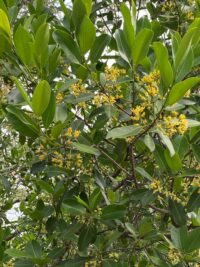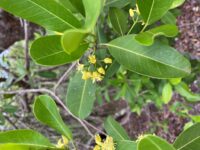Acronychia imperforata, commonly known as the Fraser Island Apple or the Scrub Lemon, is a species of small to medium-sized tree native to Australia.
It offers a range of uses spanning traditional medicine, culinary applications, horticulture, and ecological restoration.
Taxonomy:
- Family: Rutaceae
- Genus: Acronychia
Description:
- Growth: Glossy, dark green leaves, which are elliptic to ovate in shape and arranged oppositely along the branches. The tree typically grows to heights ranging from 5 to 15 meters. Bark Smooth and grayish-brown.
- Leaves: Glossy, dark green on the upper surface. Elliptic to ovate, 6 to 12 centimeters in length and 2 to 5 centimeters in width.
- Fruit: Small, round berry that starts green and turns yellow or orange as it ripens. It resembles a tiny apple or lemon, hence the common names “Fraser Island Apple” and “Scrub Lemon.”
- Flowers: Small, white flowers in clusters, which emit a pleasant fragrance.
Habitat and Distribution:
Acronychia imperforata is primarily found in subtropical and tropical rainforests, as well as coastal areas. It tends to grow in moist, well-drained soils. This species is endemic to Australia, particularly along the eastern coast. It is notably found in Fraser Island, Queensland, from which it derives one of its common names.
Hosts: (included but not limited to)
- Australasian Figbird (Sphecotheres vieilloti): This bird species is known for its diet consisting mainly of fruits. The berries provide a nutritious food source, especially during fruiting season. The figbird helps in seed dispersal as it consumes the fruit and excretes the seeds elsewhere, facilitating the growth of new trees.
- Satin Bowerbird (Ptilonorhynchus violaceus): Feeds on the fruit dispersing the seeds through their droppings, these birds contribute to the regeneration of the tree in various parts of its habitat.
- Silvereye (Zosterops lateralis): This small bird uses the dense foliage for nesting. The leaves provide excellent camouflage and protection from predators, ensuring a safe environment for raising their young.
- Common Crow Butterfly (Euploea corinna): The larvae of this butterfly species feed on the leaves. The tree thus serves as a crucial host plant during the larval stage, providing the necessary nutrients for growth and development.
- Sugarbag bee (Tetragonula carbonaria): These native bees are vital for pollination. The flowers attract these bees, which in turn help in the transfer of pollen, facilitating successful reproduction of the tree.
- Honeybees (Apis mellifera): Although not native, honeybees also visit the flowers for nectar, playing a role in pollination.
Ecology and Uses:
- Ecological Role: The Fraser Island Apple tree provides habitat and food for various wildlife, including birds and insects.
- Cultural and Traditional Uses: Indigenous Australian communities have historically used parts of the tree for medicinal purposes, including treatments for coughs and colds.
- Ornamental Purposes: In addition to its ecological and cultural significance, Acronychia imperforata is also cultivated as an ornamental tree in gardens and parks, valued for its attractive foliage, fragrant flowers, and colorful fruit.
- Edible Fruit: While not commonly consumed on a large scale, the fruit of Acronychia imperforata is edible. It has a tangy, citrus-like flavor with a slightly sweet undertone. You may incorporate the ripe fruit into jams, jellies, or desserts. Additionally, the fruit can be used to add flavor to sauces, marinades, or beverages.
Links:
Acronychia imperforata : Logan Apple | Atlas of Living Australia (ala.org.au)



